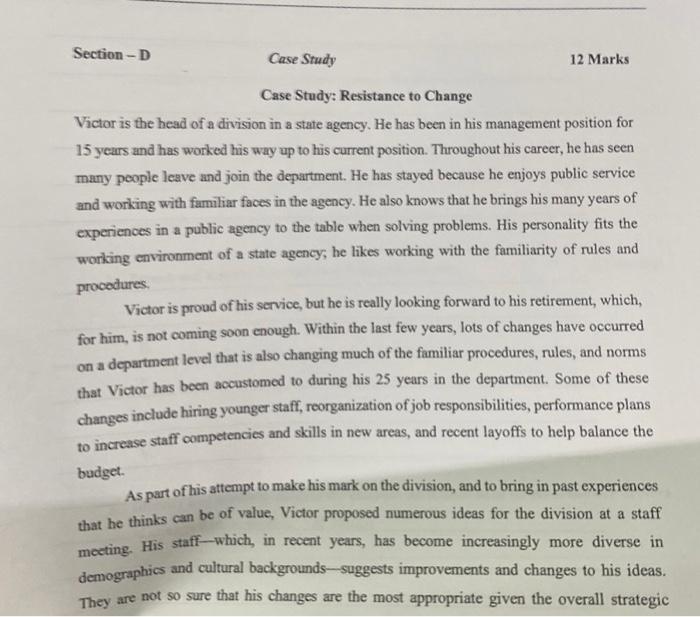Case Study: Resistance to Change Victor is the head of a division in a state agency. He has been in his management position for 15 years and has worked his way up to his current position. Throughout his career, he has seen many people leave and join the department. He has stayed because he enjoys public service and working with familiar faces in the agency. He also knows that he brings his many years of experiences in a public agency to the table when solving problems. His personality fits the working environment of a state agency, he likes working with the familiarity of rules and procodures. Victor is proud of his service, but he is really looking forward to his retirement, which, for him, is not coming soon enough. Within the last few years, lots of changes have occurred on a department level that is also changing much of the familiar procedures, rules, and norms that Victor has been accustomed to during his 25 years in the department. Some of these changes include hiring younger staff, reorganization of job responsibilities, performance plans to increase staff competencies and skills in new areas, and recent layoffs to help balance the budget. As part of his attempt to make his mark on the division, and to bring in past experiences that he thinks can be of value, Victor proposed numerous ideas for the division at a staff mecting. His staff-which, in recent years, has become increasingly more diverse in demographics and cultural backgrounds - suggests improvements and changes to his ideas. They are not so sure that his changes are the most appropriate given the overall strategic directions of the department. Furthermore, they are not sure how they can implement strategies when the ideas call for outdated resources and technology. Some of the younger staff members Victor to accomplishing the divisien souls and practices in strategic thinking that could be more beneficial to accomplishing the division goals. of the staff. He feels like suggestions as attacks directed at him and as resistance on the part of the younger staff members. He knows the the sugestion, he is thrown a curveball from one dynamic go on for an additional five years he has to manage this. He cannot let this type of Questions 1. What cultural assumptions fuel Victor's perspective as a leader of a state agency? 2. Where does Victor's motivation to lead come from? (3 Marks) 3. How would you describe Victor's self-concept and the influence of it on his leadership? 4. What strategies does Victor use to influence change within (3Mis Marks) (programmatic or participatory communication strategies)? Explain wision from the case study








